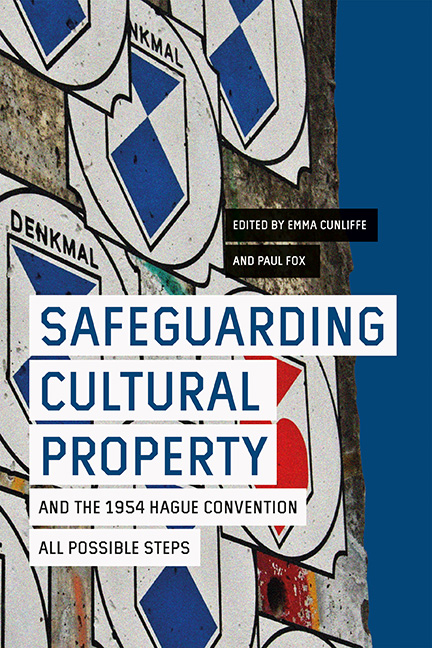Book contents
- Frontmatter
- Contents
- List of Illustrations
- List of Contributors
- Plate Section
- Acknowledgements
- List of Abbreviations
- Preface: The Blue Shield and the Protection of the World's Cultural Property – Preparing in Peace for Conflict
- Part I Safeguarding – Reassessing the Field
- Part II Historical Perspectives
- Part III Current Issues in Legal Implementation
- Part IV The Hague Convention in Practice Today: Tools and Approaches
- Appendix 1 The Hague Convention for the Protection of Cultural Property in the Event of Armed Conflict with Regulations for the Execution of the Convention 1954
- Appendix 2 Regulations for the Execution of the Convention for the Protection of Cultural Property in the Event of Armed Conflict
- Appendix 3 Resolutions of the 1954 Hague Conference
- Appendix 4 Second Protocol to the Hague Convention of 1954 for the Protection of Cultural Property in the Event of Armed Conflict 1999
- Appendix 5 Additional Protocols (1977) to the Geneva Conventions (1949) (Extracts)
- Index
- HERITAGE MATTERS
2 - Centres Containing Monuments, Open Cities and Sanctuaries for Art: ‘Super-refuges’ from the First World War to the 1954 Hague Convention
Published online by Cambridge University Press: 26 May 2022
- Frontmatter
- Contents
- List of Illustrations
- List of Contributors
- Plate Section
- Acknowledgements
- List of Abbreviations
- Preface: The Blue Shield and the Protection of the World's Cultural Property – Preparing in Peace for Conflict
- Part I Safeguarding – Reassessing the Field
- Part II Historical Perspectives
- Part III Current Issues in Legal Implementation
- Part IV The Hague Convention in Practice Today: Tools and Approaches
- Appendix 1 The Hague Convention for the Protection of Cultural Property in the Event of Armed Conflict with Regulations for the Execution of the Convention 1954
- Appendix 2 Regulations for the Execution of the Convention for the Protection of Cultural Property in the Event of Armed Conflict
- Appendix 3 Resolutions of the 1954 Hague Conference
- Appendix 4 Second Protocol to the Hague Convention of 1954 for the Protection of Cultural Property in the Event of Armed Conflict 1999
- Appendix 5 Additional Protocols (1977) to the Geneva Conventions (1949) (Extracts)
- Index
- HERITAGE MATTERS
Summary
In a recent paper (Pollard 2020a), I argued that the 1954 Hague Convention for the Protection of Cultural Property in the Event of Armed Conflict’s (‘the Convention’) provision for refuges for movable items of cultural property reflects, to a very great degree, the lessons of the Second World War; and I evaluated that Convention's under-used regulations and procedures for refuges under Special Protection in the context of Italian experience during the Second World War. My conclusion was that ‘Hague-type’ refuges (publicly known and under international supervision) remain an important tool in national strategies for cultural property protection, and arguments that they are obsolete are misguided. This paper complements the earlier one by examining the other key area of Special Protection in the 1954 Hague Convention, namely ‘centres containing monuments and other immovable cultural property of very great importance’ (Hague 1954, Article 8(1)). I argue that this provision too reflects debate and experience in the Second World War (and in the inter-war period preceding it). In the case of ‘centres containing monuments’, it seems clear to me that their protection developed from a very specific wartime and pre-war concept that a few centres of preeminent existing cultural importance could be designated ‘open cities’ to also serve as ‘super-refuges’ for portable cultural property; thus, as it were, killing two birds with one stone. However, perhaps in the Convention's drafting or its subsequent development, the concept was broadened in a way that really does weaken it to the point where it becomes unworkable in practical terms.
‘CENTRES CONTAINING MONUMENTS’
The inclusion within the 1954 Hague Convention of ‘centres containing monuments’ as a particular category of protected cultural property raises a number of difficulties. The term is first employed in the general definition of cultural property in Article 1(c), which refers to ‘centres containing a large amount of cultural property as defined in sub-paragraphs (a) and (b), to be known as “centres containing monuments”.’ Sub-paragraph (a) describes the full range of individual sites, structures, and objects, movable and immovable, covered by the convention as cultural property, while sub-paragraph (b) focuses on structures such as museums, archives, libraries, and refuges whose function is to preserve, exhibit, and shelter the cultural property defined in sub-paragraph (a).
- Type
- Chapter
- Information
- Safeguarding Cultural Property and the 1954 Hague ConventionAll Possible Steps, pp. 39 - 56Publisher: Boydell & BrewerPrint publication year: 2022



